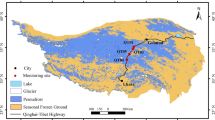Abstract
Alpine cold ecosystem with permafrost environment is quite sensitive to climatic changes and the changes in permafrost can significantly affect the alpine ecosystem. The vegetation coverage, grassland biomass and soil nutrient and texture are selected to indicate the regime of alpine cold ecosystems in the Qinghai-Tibet Plateau. The interactions between alpine ecosystem and permafrost were investigated with the depth of active layer, permafrost thickness and mean annual ground temperature (MAGTs). Based on the statistics model of GPTR for MAGTs and annual air temperatures, an analysis method was developed to analyze the impacts of permafrost changes on the alpine ecosystems. Under the climate change and human engineering activities, the permafrost change and its impacts on alpine ecosystems in the permafrost region between the Kunlun Mountains and the Tanggula Range of Qinghai-Tibet Plateau are studied in this paper. The results showed that the permafrost changes have a different influence on different alpine ecosystems. With the increase in the thickness of active layer, the vegetation cover and biomass of the alpine cold meadow exhibit a significant conic reduction, the soil organic matter content of the alpine cold meadow ecosystem shows an exponential decrease, and the surface soil materials become coarse and gravelly. The alpine cold steppe ecosystem, however, seems to have a relatively weak relation to the permafrost environment. Those relationships resulted in the fact that the distribution area of alpine cold meadow decreased by 7.98% and alpine cold swamp decreased by 28.11% under the permafrost environment degradation during recent 15 years. In the future 50 years the alpine cold meadow ecosystems in different geomorphologic units may have different responses to the changes of the permafrost under different climate warming conditions, among them the alpine cold meadow and swamp ecosystem located in the low mountain and plateau area will have a relatively serious degradation. Furthermore, from the angles of grassland coverage and biological production the variation characteristics of high-cold ecosystems in different representative regions and different geomorphologic units under different climatic conditions were quantitatively assessed. In the future, adopting effective measures to protect permafrost is of vital importance to maintaining the stability of permafrost engineering and alpine cold ecosystems in the plateau.
Similar content being viewed by others
References
Wu Q B, Shi B, Liu Y Z. Interaction study of permafrost and highway along Qinghai-Xizang Highway. Sci China Ser D-Earth Sci, 2003, 46(2): 97–105
Walker D A, Jia G J, Epstein H E, et al. Vegetation-soil-thawdepth relationships along a low-arctic bioclimate gradient, Alaska: synthesis of information from the ATLAS studies. Permafrost and Periglacial Processes, 2003, 14: 103–123
McGuire A D. Environmental variation, vegetation distribution, carbon dynamics and water/energy exchange at high latitudes. J Veg Sci, 2002, 13(3): 301–314
Christensen T R, Johansson T, Kerman H J, et al. Thawing sub-arctic permafrost: Effects on vegetation and methane emissions. Geophys Res Lett, 2004, 31: L04501
Sazonova T S, Romanovsky V E. A model for regional-scale estimation of temporal and spatial variability of active layer thickness and mean annual ground temperatures. Permafrost and Periglacial Processes, 2003, 14: 125–139
Stendel M, Christensen J H. Impact of global warming on permfrost conditions in a coupled GCM. Geophys Res Lett, 2002, 29(13): 101–104
Wang G S, Jin H J, Lin Q. Changes of natural and engineering environments of permafrost regions along the Qinghai-Tibet highway. J Glaciol Geocry, 1998, 20(4): 444–450
Zhao L, Chen G C, Cheng G D, et al. Permafrost: status, variation and impacts. In Zheng D, ed. Mountain Geoecology and Sustainable Development of the Tibetan Plateau. Dordrecht: Kluwer Academic Publishers, 2000, 113–137
Wu Q B, Li X, Li W J. The prediction of permafrost change along the Qinghai-Tibet Highway, China. Permafrost and Periglacial Processes, 2000, 11(4): 371–376
Wang G X, Yao J Z, Guo Z G, et al. The change of permafrost ecosystem under human activity and its apocalypse to railway construct. Chin Sci Bull, 2004, 49(15): 1556–1564
Cheng G D, Wang S L. On the zonation of high-altitude permafrost in China. J Glaciol Geocry, 1982, 4(2): 1–17
Tong C J, Wu Q B. The effect of climate warming on the Qinghai-Tibet highway, China. Cold Reg Sci Tech, 1996, 24: 105–106
Li W H, Zhou X M. The Ecosystem of Qinghai-Tibet Plateau and Its Optimizing Utilized Model (in Chinese). Guangzhou: Guangzhou Science and Technology Press, 1998. 19–67
Zhou X X. Chinese Kobresia Pygmaea Meadow (in Chinese). Beijing: Science Press, 2001. 188–206
Wang G X, Cheng G D, Shen Y P, et al. Research on Ecological Environmental Changes in Changjinag-Yellow Rivers Source Regions and Their Integrated Protection (in Chinese). Lanzhou: Lanzhou University Press, 2001. 11–107
Wu Q B, Li X, Li W J. Computer simulation and mapping of the regional distribution of permafrost along the Qinghai-Xizang highway. J Glac Geocry, 2000, 22(4): 323–326
Wu Q B, Li X, Li W J. The response model of permafrost along the Qinghai-Tibetan Highway under climate change. J Glac Geocry, 2001, 23(1): 1–6
Zhou Y W, Guo D X, Qiu G Q, et al. The Permafrost in China (in Chinese). Beijing: Science Press, 2000. 27–269
Zhou X M, Wang Z B, Du Q. The vegetation in Qinghai Province (in Chinese). Xining: Qinghai People’s Press, 1987. 11–74
Wang G X, Li Q, Cheng G D, et al. Climate change and its impact on the eco-environment in the source regions of Yangtze and Yellow Rivers in recent 40 years. J Glac Geocry, 2001, 23(4): 346–352
Zhao L, Chen G D, Li S X. The permafrost active layer’s freeze and melt process nearby Wudaoliang of Qinghai-Tibet Plateau. Chin Sci Bull, 2001, 45(11): 1205–1211
Author information
Authors and Affiliations
Corresponding author
Rights and permissions
About this article
Cite this article
Wang, G., Li, Y., Wu, Q. et al. Impacts of permafrost changes on alpine ecosystem in Qinghai-Tibet Plateau. SCI CHINA SER D 49, 1156–1169 (2006). https://doi.org/10.1007/s11430-006-1156-0
Received:
Accepted:
Issue Date:
DOI: https://doi.org/10.1007/s11430-006-1156-0




